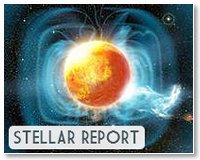 |
Cambridge, Mass. (UPI) Oct 14, 2010 U.S. astronomers say they've discovered the biggest galaxy cluster ever seen, a massive grouping of hundreds of galaxies 7 billion light-years from Earth. Researchers from the Harvard-Smithsonian Center for Astrophysics found the cluster using the South Pole Telescope, a Harvard release said. "This galaxy cluster wins the heavyweight title. It's among the most massive clusters ever found at this distance," said Mark Brodwin, a Smithsonian astronomer at the center. Because it's 7 billion light-years distant, we're seeing it as it was 7 billion years ago when the universe was only half its present age and our solar system didn't exist yet, researchers say. "This cluster is full of 'old' galaxies, meaning that it had to come together very early in the universe's history -- within the first 2 billion years," Brodwin said. The Harvard-Smithsonian team said it expects to find many more giant galaxy clusters once the South Pole Telescope survey is completed. "After many years of effort, these early successes are very exciting. The full SPT survey, to be completed next year, will rewrite the book on the most massive clusters in the early universe," Brodwin said.
Share This Article With Planet Earth
Related Links Stellar Chemistry, The Universe And All Within It
 Scientist ready to 'weigh' distant stars
Scientist ready to 'weigh' distant starsCambridge, Mass. (UPI) Oct 15, 2010 Determining the weight of a distant star usually yields just an estimate, but one U.S. scientist says in special cases a star can be "weighed" directly. Astronomers have found more than 90 planets that cross in front of, or transit, their stars, and by measuring the amount of starlight that's blocked, they can calculate how big the planet is relative to the star. But they can't know exa ... read more |
|
| The content herein, unless otherwise known to be public domain, are Copyright 1995-2010 - SpaceDaily. AFP and UPI Wire Stories are copyright Agence France-Presse and United Press International. ESA Portal Reports are copyright European Space Agency. All NASA sourced material is public domain. Additional copyrights may apply in whole or part to other bona fide parties. Advertising does not imply endorsement,agreement or approval of any opinions, statements or information provided by SpaceDaily on any Web page published or hosted by SpaceDaily. Privacy Statement |